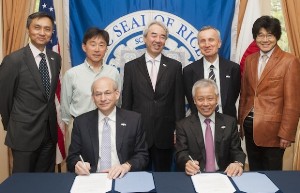Apr 8 2014
Rice University and the University of Tokyo have signed a memorandum of understanding (MOU) to begin an ongoing academic exchange.
 Rice University and the University of Tokyo plan to collaborate on research initiatives and exchange students with an agreement signed on April 1 at Rice. Photo by Jeff Fitlow
Rice University and the University of Tokyo plan to collaborate on research initiatives and exchange students with an agreement signed on April 1 at Rice. Photo by Jeff Fitlow
Rice President David Leebron and Tokyo Executive Vice President Yoichiro Matsumoto finalized the agreement April 1 at Rice. The universities plan to exchange undergraduate and graduate students, as well as research initiatives, for at least the next five years.
“We’re very pleased to have an opportunity to build a deep and wide collaboration with one of the premier universities in the world, the University of Tokyo,” Leebron said. “We have a long relationship with the university, and I’m very happy to see Rice take another step in deepening this relationship. Expanding Rice’s international outreach remains an ongoing priority for our university.”
“For many years we have been hoping for an MOU with Rice University,” Matsumoto said, noting connections that include carbon nanotube research by Professor Shigeo Maruyama of Tokyo’s Department of Mechanical Engineering with Rice Nobel Laureate Richard Smalley since the early 1990s.
Maruyama was a visiting fellow in Smalley’s Rice lab from 1989 to 1991 and was present for the signing. He continues to collaborate with Junichiro Kono, a professor of electrical and computer engineering, of physics and astronomy and of materials science and nanoengineering at Rice on the NanoJapan program that sends U.S. freshman and sophomore undergraduates to work in Japanese nanoscale science research labs every summer. The University of Tokyo has been one of the host universities for NanoJapan since the program’s inception in 2006.
Matsumoto, a mechanical engineer, and Tayfun Tezduyar, the James F. Barbour Professor of Mechanical Engineering at Rice and a fellow of School of Engineering at Tokyo, met at a Tokyo symposium in 1997. The two started the institutional discussions on an exchange agreement soon after Tezduyar arrived at Rice in December 1998. They have since enjoyed a working collaboration on computational fluid mechanics and fluid-structure interaction.
Matsumoto expects as many as 10 graduate and undergraduate students will be exchanged in the first years of the program, with the further possible exchange of faculty and administrative staff and researchers, collaborative research, joint lectures and symposia and an exchange of academic information and materials.